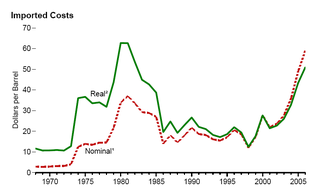Related Research Articles

The Middle East is a geopolitical region encompassing the Arabian Peninsula, the Levant, Turkey, Egypt, Iran, and Iraq. The term came into widespread usage as a replacement of the term Near East beginning in the early 20th century. The term "Middle East" has led to some confusion over its changing definitions, and being seen as too Eurocentric. The region includes the vast majority of the territories included in the closely associated definition of West Asia, but without the South Caucasus, and additionally includes all of Egypt and all of Turkey.

The Organization of the Petroleum Exporting Countries is an organization enabling the co-operation of leading oil-producing countries in order to collectively influence the global oil market and maximize profit. It was founded on 14 September 1960 in Baghdad by the first five members. The 12 member countries account for an estimated 30 percent of global oil production.

The Middle East and North Africa is a geographic region whose countries are often referred to by the acronym MENA.

The economy of the Middle East is very diverse, with national economies ranging from hydrocarbon-exporting rentiers to centralized socialist economies and free-market economies. The region is best known for oil production and export, which significantly impacts the entire region through the wealth it generates and through labor utilization. In recent years, many of the countries in the region have undertaken efforts to diversify their economies.
For further details see the "Energy crisis" series by Facts on File.

Iran has the Third largest oil reserves and the 2nd largest natural gas reserves in the world. The nation is a member of OPEC, and generates approximately 50% of state revenue through oil exports.
The Demographics of the Middle East describes populations of the Middle East, a region covering western and northern parts of the Asian and African continents respectively.

EnergyinSaudi Arabia involves petroleum and natural gas production, consumption, and exports, and electricity production. Saudi Arabia is the world's leading oil producer and exporter. Saudi Arabia's economy is petroleum-based; oil accounts for 90% of the country's exports and nearly 75% of government revenue. The oil industry produces about 45% of Saudi Arabia's gross domestic product, against 40% from the private sector. Saudi Arabia has per capita GDP of $20,700. The economy is still very dependent on oil despite diversification, in particular in the petrochemical sector.
Energy security of the People's Republic of China concerns the need for the People's Republic of China to guarantee itself and its industries long- term access to sufficient energy and raw materials. China has been endeavoring to sign international agreements and secure such supplies; its energy security involves the internal and foreign energy policy of China. Currently, China's energy portfolio consists mainly of domestic coal, oil and gas from domestic and foreign sources, and small quantities of uranium. China has also created a strategic petroleum reserve, to secure emergency supplies of oil for temporary price and supply disruptions. Chinese policy focuses on diversification to reduce oil imports, which used to rely almost exclusively on producers in the Middle East.

This article describes the energy and electricity production, consumption and import in Egypt.

The 1970s energy crisis occurred when the Western world, particularly the United States, Canada, Western Europe, Australia, and New Zealand, faced substantial petroleum shortages as well as elevated prices. The two worst crises of this period were the 1973 oil crisis and the 1979 energy crisis, when, respectively, the Yom Kippur War and the Iranian Revolution triggered interruptions in Middle Eastern oil exports.

The water-energy nexus is the relationship between the water used for energy production, including both electricity and sources of fuel such as oil and natural gas, and the energy consumed to extract, purify, deliver, heat/cool, treat and dispose of water sometimes referred to as the energy intensity (EI). Energy is needed in every stage of the water cycle from producing, moving, treating and heating water to collecting and treating wastewater. The relationship is not truly a closed loop as the water used for energy production need not be the same water that is processed using that energy, but all forms of energy production require some input of water making the relationship inextricable.

Energy in Qatar describes energy production, consumption, and policies of the State of Qatar. The International Monetary Fund ranked Qatar as having the fifth highest GDP per capita in 2016 with a 60,787 USD per capita nominal GDP over a population of 2.421 million inhabitants. In 2014, oil and natural gas production made up 51.1% of Qatar's nominal GDP. Thus, Qatar has a worldwide high ranking of per capita GDP due to its significance production and exports in both crude oil and natural gas in proportion to its relatively small population.
Energy in Kuwait describes energy and electricity production, consumption, import and export in Kuwait.

The energy sector of Iraq is mostly concentrated around oil and gas.
Energy in the United Arab Emirates describes energy and electricity production, consumption and import in the United Arab Emirates (UAE). The UAE has 7% of global proved oil reserves, about 100 billion barrels. Primary energy usage in 2009 in the UAE was 693 TWh and 151 TWh per million persons.

Environmental issues in the United Arab Emirates (UAE) are caused by the exploitation of natural resources, rapid population growth, and high energy demand. The continuing temperature rise caused by global warming contributes to UAE's water scarcity, drought, rising sea level, and aridity. The countryside of the UAE, characterized with its great arid land, infrequent precipitation, and high temperatures are already facing long-term aridity. This precondition is very vulnerable to the effects of climate change and contributes to worsening water scarcity, quality, and water contamination.

World energy supply and consumption refers to the global primary energy production, energy conversion and trade, and final consumption of energy. Energy can be used in various different forms, as processed fuels or electricity, or for various different purposes, like for transportation or electricity generation. Energy production and consumption are an important part of the economy. A serious problem concerning energy production and consumption is greenhouse gas emissions. Of about 50 billion tonnes worldwide annual total greenhouse gas emissions, 36 billion tonnes of carbon dioxide was emitted due to energy in 2021.
References
- ↑ IEA Key energy statistics 2010 Archived 2010-10-11 at the Wayback Machine Page: Country specific indicator numbers from page 48
- 1 2 IEA Key World Energy Statistics 2012 Archived 2013-03-09 at the Wayback Machine , Country specific indicator numbers from page 48
- 1 2 2011 report on oil and gas companies, Promoting revenue Transparency Archived 2011-06-02 at the Wayback Machine Transparency International 2011 pages 113-115
- ↑ Fattouh B, El Katiri L (2012) Energy and subsidies in the Arab world. UNDP Arab Human Development Report Research Paper Series, Regional Bureau for Arab States, New York
- ↑ RCREEE (2015) Arab Future Energy Index (AFEX). Regional Centre for Renewable Energy and Energy Efficiency (RCREEE), Cairo, Egypt
- ↑ Amer, Kamel, et al., editors. The Water, Energy, and Food Security Nexus in the Arab Region. 1st ed., ser. 2367-4008, Springer International Publishing, 2017.
- ↑ Badran, Adnan, et al., editors. Water, Energy, & Food Sustainability in the Middle East. 1st ed., ser. 978-3-319-48920-9, Springer International Publishing, 2017.
- ↑ World carbon dioxide emissions data by country: China speeds ahead of the rest Guardian 31 January 2011
- ↑ Which nations are most responsible for climate change? Guardian 21 April 2011
- ↑ "Kigali climate change deal: Will the Middle East keep its cool?". Journal of Middle Eastern Politics and Policy. 25 October 2016.
